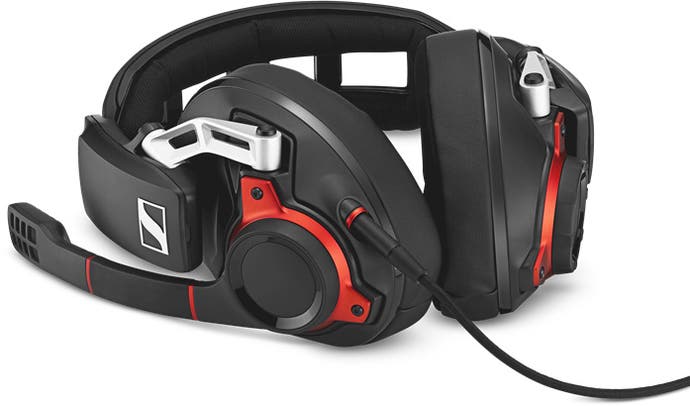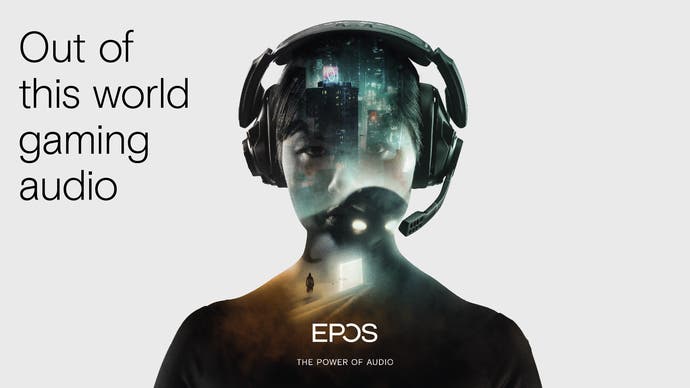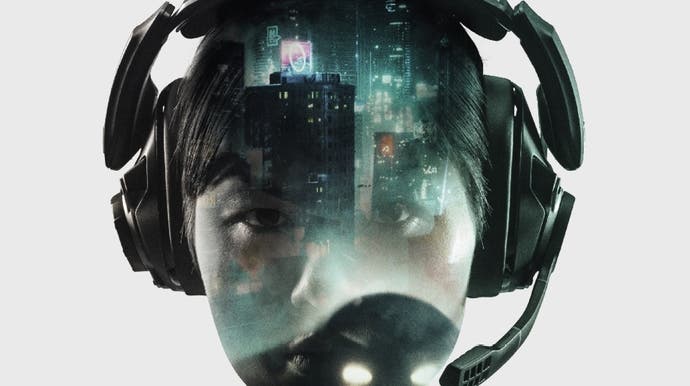The EPOS tech interview: designing gaming headsets for esports and immersion
The artists formerly known as Sennheiser's gaming division.
Sennheiser is one of the most legendary names in audio, a German firm that makes both well-regarded headphones for critical music listening as well as some of the best gaming headsets on the market. Its gaming division is set for a change though, as it is now set to de-merge from Sennheiser and become a new independent entity: EPOS.
The new company will continue to offer a line of existing products under a new co-branding scheme, including two of our favourite premium wireless headsets, the GSP 370 and GSP 670, which we like for their durable (if bulky) design, long battery life and generally warm, inviting sound. Of course new products are also coming, including one we're testing at the moment - the GSX 300 external sound card. We haven't finished our review yet, but so far we've been impressed with the device's clean industrial design and even cleaner audio. It's an encouraging first step, but the company will need several successes on the trot to bring the same cachet that Sennheiser enjoys to the new EPOS name.
To mark the re-launch, we spoke with EPOS' senior director of product Andreas Jessen about the new company's design process, its future lineup and the most important headphone features for competitive or immersive gaming. Enjoy!
What does the headset design process look like? Does new technology drive the development of a product that hits an appropriate segment, or vice versa?
The design process comes from two angles. First, we look at what makes an EPOS design, what are the unique elements that we can truly say make an EPOS product. Some of these include the comfortable ear-shaped earcup, the floating oblong design on our newer products, and the single-sided yoke - used to give the ear cup more rotation, and thus a better fit. We want people to be able to recognize an EPOS headset and for us to have a somewhat shared expression across our portfolio. Sometimes we succeed really well with that, and sometimes we just find something that looks really cool, so we take a first step in a new direction. Secondly, we look at what is popular in the market - this is more related to color choices, material choices and surface treatments. In the end, what matters is the overall design of the product as well as the user experience to ensure a premium audio solution.
How do you balance the needs of core and hardcore players?
There is a lot of overlap of course, so it is not like we can say that hardcore players need better audio than core - they both need the best audio possible!
What we have learned by working with some of the more hardcore players, is that they really want two main things from the equipment: trust and control. When we create products for the really hardcore players, we make sure that they are not drowned in advanced features and we make sure the player is always in control. For more core players that like to experiment and have time to do this, we offer more features and ways to enrich their audio experience.
Apart from imaging, what headphone features are most useful for competitive gaming?
Balanced speakers (L/R) are vital to ensure you have the best starting point for localising sounds.
A tightly controlled mid-range that does not fluctuate too many decibels over a wide range of spectrum is also key. If you suddenly have a 5dB spike between 700Hz and 1200Hz, then sound being played in that spectrum would sound closer than it actually is in the virtual space - not ideal when you're trying to locate other players. A flat, controlled mid-range is extremely important if you want to be able to trust your equipment.
What headphone features are most important for immersive experiences?
Making our product portfolio easier to navigate is a big part of our future plans - watch this space!
For an immersive headset experience, the important headset features depend a little on exactly what you are looking for. In terms of audio philosophy, we usually go after an increased bass response and then an increased high end - with a flat mid-range in the middle. We do this because when you are wearing headsets, you do not get that body impact of audio that you would otherwise get when experiencing something in real life. In order to trick your brain into getting that full body experience, we have to increase the low frequency response. When we do that, we need to also balance this out with a controlled boost of the high frequency to achieve a good tonal balance. This is truly a balancing act, and if you go too far in the low range, you end up with muddy voices. If you go too aggressive in the high range, you end up with hi-hat from a drum set hurting your ears.
Right now, EPOS' lineup of gaming headsets is complicated. There are two wireless headsets - understandable enough - but nine wired models with the same basic design and relatively little different between them upon initial inspection. Are there any plans to simplify these options under the new brand?
We always strive to make our portfolio as easy to understand as possible and have a long-term commitment to ensure it is clean and simple. Currently, we have a range of wired analogue headsets that are split between two main categories - open acoustics and closed acoustics. Additional to this, there is a small lineup of USB headsets and two wireless headsets in the product range.
We are constantly in the process of evaluating whether a product is still a good fit with what gamers want or if we should either phase-out a product or replace it with a next generation or new model - making our product portfolio easier to navigate, amongst others through stronger communication, is a big part of our future plans - watch this space!

Despite some models being quite comfortable to wear - e.g. the GSP 370 - the EPOS gaming headsets almost universally have quite a tough and bulky-looking design. Is this a core design trait, or something that you would be open to changing?
Design for us is important, and we are of course looking at how we can make our headsets more aesthetically pleasing. Our current design priority is based on zero compromise for comfort. When we investigated what would make the most comfortable headset, we wanted to have a lot of room for the ear as this plays a huge part in how the headset feels during extended wear. Our research has shown that in order to be truly comfortable, there needs to be a big area of touch between the ear and the ear pad and we also wanted to make sure the speaker had enough air to "breathe". The trade-off here is that, yes, the headset may look a bit bulky.
However, we are always trying to push the limits of what can be done in terms of design, and to do that we are working hard both on mechanical, digital, and material innovation.
For gaming, open back headphones are much less common than closed back alternatives; do you feel the Game One does enough to fill that gap for EPOS or is there room for a wider lineup?
In addition to the Game One, the GSP 500 is an open backed version of our legendary wired headset, the GSP 600, but there is always room for looking into a wider lineup. Open acoustic is not the traditional choice for gamers, although it offers a lot of benefits that have a big potential for gamers. For one, we believe that an open acoustic headset can offer better immersion as it does not give that headphone feeling (occlusion) that some closed headsets do. As gamers can often live with the drawbacks of open acoustics - such as when others can hear you and you can hear them and enjoy the positives.
Furthermore, open acoustics have the added benefit of offering some ventilation to your ears.

The likes of Nvidia and Asus have joined traditional audio companies in developing AI-driven solutions for eliminating background noise. Is there AI-focused research going on at EPOS as well? What do you think of its potential?
At EPOS, it is the audio engineering behind our products that make all the difference. When it comes to our technologies we never stand still. We aim to transform ideas and new possibilities into better audio solutions. We do this by looking at audio holistically and by engineering every single detail. The use of Artificial Intelligence is, of course, an integral part of the technical side of our products that aims to elevate the wearer's audio experience.
Will we see any more affordable EPOS gaming headsets in future, or will the brand remain mid-range to high-end?
We have some minimum quality standards for what we can put the EPOS name on, and that reflect our price point and commitment to superior quality in our products. However, it is our clear ambition to be the preferred gaming brand for gamers who appreciate expertly engineered audio made for gaming, so if we have a higher price point, that just means we are obliged to offer a higher quality product offering.
What are your thoughts on 5.1 and 7.1 surround sound modes on headsets? These features are a popular inclusion on high-end models, but professional gamers (and competitive players seeking to emulate them) invariably use stereo in-ear headphones or headsets when competing as this makes it easier to locate enemies in shooters like Valorant or CSGO.
If we look at virtual surround sound in general, what it does is that it provides more data using the same audio source. You can suddenly separate audio much better and to a smaller degree than stereo.
Why spend up to $1000 on a graphics card, maybe $800 on a screen and peripherals, just to destroy the experience by getting a $30 headset?
However, what we currently see is that a lot of competitive players have "grown-up" with stereo, and a lot of the training and instinct is based on stereo, so for them stereo tends to be the preferred solution due to tradition. We do believe that if players started with surround and got used to the extra informational layer in surround, then they would experience that 7.1 or 5.1 offers a competitive advantage.
Again, this depends on the actual algorithm that you use - at EPOS we have our own proprietary technology that we developed especially for gaming. What makes our algorithm stand out is our ability to separate the back speakers more clearly and have a really reverb-flat implementation, so you don't get that locked-in-the-bathroom feeling.
What differentiates EPOS gaming headsets from the competition, really?
We for a long time have had the mantra that we create tools not toys! When we started looking more seriously at gaming several years ago, we concluded that a lot of the offerings out there were dominated by cheap plastic products with subpar quality compared to other headset segments we saw. We want to lift the quality of the products to an audiophile level that we believe gamers deserve. Why spend up to $1000 on a graphics card, maybe $800 on a screen and other peripherals, just to destroy the whole experience by getting a $30 headset? That does not make sense!










